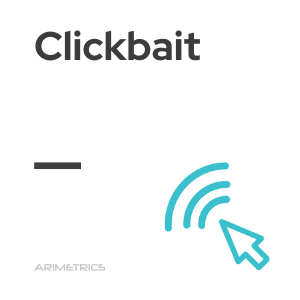
Description:
The term clickbait refers to a part of the content (usually the headline, although it can be an image, video, etc.) that intentionally promises, misrepresents or manipulates to attract users to a particular website. The intention of clickbait is to generate enormous traffic to the web or a certain video and also create brand awareness.
Clickbait as a source of traffic
Clickbaiting has become an increasingly popular technique, especially in the context of websites that rely on advertising models such as cost per thousand impressions(CPM). By using this strategy occasionally and in combination with quality content, it is possible to experience a noticeable increase in web traffic. Eye-catching and provocative headlines can capture the attention of the audience, leading them to click through and explore the content. It is important however that the content targeted to users meets the expectations generated by the headline, otherwise the effectiveness of the strategy will be compromised.
Disadvantages of clickbait
Although clickbait may seem like an attractive technique for increasing traffic to a website, it also comes with a number of drawbacks that should not be ignored. If the linked content does not meet the expected quality standards, the strategy is likely to have negative effects. From an SEO point of view, excessive use of clickbait can be counterproductive. Although an increase in the number of visits may be generated, a high bounce rate and poor user experience can negatively affect the site’s search engine ranking.
In addition, users may come to perceive a lack of authenticity on sites that abuse clickbait, which can damage the brand’s reputation in the long run. When visitors realize that they have been misled by a sensational headline that does not reflect the actual content, they are likely to be disappointed and distrustful of the brand. This negative perception can result in a loss of credibility and, ultimately, a decrease in customer loyalty. Therefore, it is essential that brands use clickbait with caution and ensure that the content they offer is valuable and relevant to their audience.
Examples of clickbait
Clickbait comes in various forms, and its main purpose is to capture the reader’s attention through sensational or intriguing headlines. Several common types of clickbait are described below, along with specific examples and explanations of their effectiveness:
- Sensational headlines: This type of headline appeals to the reader’s curiosity, especially in the context of celebrity culture. Using exclamations and promises of surprising revelations can prompt users to click to satisfy their curiosity. Example: “You won’t believe what this celebrity did at her last party!”
- Intriguing questions: Questions pique the reader’s interest and invite them to search for answers. This type of clickbait is effective because it poses a mystery that the reader wants to solve, prompting them to click for information Example: “What is the one food that can help you lose weight fast?”
- Promising lists: List headlines are popular in the blogosphere and social networks because they offer concise, easy-to-digest information. The promise of quick fixes or helpful tips attracts readers, who may be motivated to explore the content. Example: “10 tricks that will change your life forever.”
- Shocking revelations: This type of clickbait plays on the reader’s emotions, generating intrigue and empathy. The idea of a shocking revelation suggests that the content is valuable and worth sharing. Example: “What this woman discovered about her family left her in shock.”
- Challenges: Challenges are an effective way to engage the reader, as they appeal to competition and curiosity. This type of content goes viral easily, as it invites users to share their experiences with friends. Example: “Try not to laugh when watching this video – it’s impossible!”
- Promises of exclusive content: The idea of gaining exclusive access to valuable information is a strong motivator for clicks. Users are often looking for ways to improve their financial situation, which makes this type of clickbait especially appealing. Example: “Watch this video to find out how to make money from home.”
- Use of numbers and statistics: Numbers and statistics add credibility to headlines and generate interest. Quantified statements are often more impactful and can prompt readers to click through to learn more about the topic. Example: “90% of people don’t know this about their health.”
- Emotional or inspirational content: Touching or inspirational stories are highly effective in attracting clicks. Users are naturally drawn to narratives that evoke emotion, which can result in higher engagement with the content. Example: “This dog saved his owner from a fire – watch how he did it!”
Difference between clickbait and linkbait
Clickbait refers to content designed to attract clicks through sensational or misleading headlines, with the primary goal of generating immediate traffic to a website. While it can result in a high number of visits, it often sacrifices the quality of the content, which can lead to a high bounce rate if users are disappointed. This strategy can damage a brand’s reputation in the long run, as readers may lose confidence in the content offered.
On the other hand, linkbait focuses on creating high-quality content that attracts links from other websites. This type of content provides real value, such as useful information or original research, which encourages others to want to share and link to it. Unlike clickbait, linkbait seeks to generate genuine interest and promote sustainable growth in web traffic, enhancing the site’s domain authority and strengthening its online reputation.
